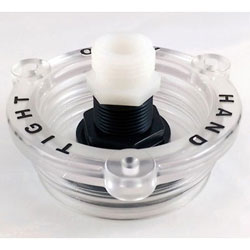dhays
Guru
- Joined
- May 26, 2015
- Messages
- 9,045
- Location
- United States
- Vessel Name
- Kinship
- Vessel Make
- North Pacific 43
There have been other threads on this but rather than dig up an old one, I started this.
After wanting to do this for several years, I finally got around to doing something about it.
I ordered one of these . I tried it out for the first time last night when we got back from our 2 week trip.

My hope was that eventually I would be able to connect a hose to this, leave the seacock open, turn on the hose full and run the engine. My thought was that the water pressure would back flush out the seacock and give the engine enough fresh water. My only question was whether the flow from the hose would be sufficient to displace the raw water and supply the engine.
To test this out I filled up a 5 gallon bucket with fresh water, attached a 5' length of hose from the strainer cap to the bottom of the bucket, closed the seacock, and started the engine. The engine drained the bucket in less than a minute!
So, I turned off the engine, refilled the bucket, and this time kept the fresh water hose filling the bucket while I started the engine. This time, the engine emptied the bucket in about 1/2 the time it did prior without the dock hose trying to keep the bucket full. A very rough guess is that I could probably supply about 10 gallons of flush water by keeping the dock hose running, start with a full bucket, and run the engine until the bucket empties.
This told me that the dock hose didn't have adequate flow to keep up with the engine's water pump and therefore my initial plan was not going to work.
So now to questions for you smart people.
1. How much water is needed to flush/replace the raw water in the Cummins heat exchanger and after-cooler? Would 10 gallons be adequate.
2. Am I missing other options?
After wanting to do this for several years, I finally got around to doing something about it.
I ordered one of these . I tried it out for the first time last night when we got back from our 2 week trip.

My hope was that eventually I would be able to connect a hose to this, leave the seacock open, turn on the hose full and run the engine. My thought was that the water pressure would back flush out the seacock and give the engine enough fresh water. My only question was whether the flow from the hose would be sufficient to displace the raw water and supply the engine.
To test this out I filled up a 5 gallon bucket with fresh water, attached a 5' length of hose from the strainer cap to the bottom of the bucket, closed the seacock, and started the engine. The engine drained the bucket in less than a minute!
So, I turned off the engine, refilled the bucket, and this time kept the fresh water hose filling the bucket while I started the engine. This time, the engine emptied the bucket in about 1/2 the time it did prior without the dock hose trying to keep the bucket full. A very rough guess is that I could probably supply about 10 gallons of flush water by keeping the dock hose running, start with a full bucket, and run the engine until the bucket empties.
This told me that the dock hose didn't have adequate flow to keep up with the engine's water pump and therefore my initial plan was not going to work.
So now to questions for you smart people.
1. How much water is needed to flush/replace the raw water in the Cummins heat exchanger and after-cooler? Would 10 gallons be adequate.
2. Am I missing other options?
